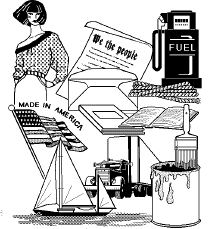 HEMP HEMP
Economic Prosperity
for a New Millenium
Compiled by BACH:
The Business
Alliance for Commerce in Hemp
Hemp in History -- Cannabis sativa, or hemp, is
our first known crop, traced back to 8000 B.C. in the Middle
East and China. Hemp textiles go back in history as far as
pottery.
Hemp was used in sails, caulk and rigging for the ships
that opened worldwide commerce. Most paper was made with
hemp for 1000s of years. Early American farmers were
reqjuired to grow it. Both the Declaration of Independence
and the Constitution were drafted on hemp. Hemp was the
world's largest single industry until the mid-1800s. The
U.S. government suspended prohibition and had farmers grow a
million acres of hemp to stop Hitler during WWII. Many
farming and industrial groups support the return of cannabis
hemp today.
A New, Multi-Billion Dollar Discovery --With over
50,000 commercial uses, today's hemp is the most versatile,
sustainable and valuable natural resource on Earth.
Conservative estimates of its profit potential surpass $500
billion per year and tens of thousands of new jobs, once the
trade barriers are removed and this valuable cash crop is
again allowed to compete. Restoring hemp to its traditional
role as the primary source of food, clothing, shelter, fuel,
paper, fiber, medicine and other consumer goods will put
money into local communities for an ecological and
financially stable economy.
Making It With Hemp -- Hemp is the temperate
climate zone's most prolific source of plant cellulose: the
basic raw material used for plastics, fabrication material,
chipboard, fiber board and other construction boards. France
makes a concrete substitute from hemp, and Henry Ford once
built and powered a car with hemp.
Hemp for Clothing -- Fabrics made from hemp are
stronger, more insulative, more absorbent and more durable
than cotton. Natural, organic hemp fiber "breathes" and is
biodegradable. With minor retooling, our textile mills can
spin and weave hemp fiber as smooth as silk, as tough as
burlap, or as intricate as lace. While the garment industry
was once a thriving part of our U.S. economy, more than half
the textiles we use today are imported, due to environmental
concerns and labor costs. Since hemp needs less fertilizer
and pesticides, we can have those jobs back&endash;without
sacrificing our ecology.
Hemp for Paper -- Paper made of hemp lasts much
longer than that made of trees, without cracking, yellowing
or otherwise deteriorating: It's the "archivist's perfect
paper." Processing hemp for paper uses far less chemical
acid than does wood. Over a 20 year period, one acre of hemp
produces as much pulp as 4.1 acres of forest land.
Hemp for Fuel &endash; The
Dept. of the Interior in May, 1991 projected crude oil costs
of $40 per barrel within 10 years. Plant "biomass" fuel is
cleaner than fossil fuels and can provide gasoline, methane,
charcoal, etc. to meet all our home and industrial energy
needs. By developing hemp, the most productive energy crop
for America's climate, we can have fuel that is both cheaper
and cleaner.
Hemp for Jobs -- As new hemp businesses open, so
will tens of thousands of new job opportunities. It
offers a basis for creating permanent economic health, even
in our rural and "rust belt" communities. Using this
sustainable resource means real job security. For example,
most timber-related jobs are not cutting trees, but the
milling, distributing, shipping, sale and use of end
products in the construction and clerical fields.
Hemp for Farms -- Hemp is so valuable that it is
now subsidized in every European country; a viable cash crop
even if grown on depleted land, between crop seasons or sown
to enrich the soil of fallow land. It was a major American
cash crop until just before the Great Depression. Today we
have a crisis of farm foreclosures, but hemp is banned
here.
A Medical & Social Herb -- Contrary to some
claims, hemp is not a dangerous drug. However, a few
seedlines, grown under proper conditions, produce the
therapeutically active herb cannabis. These plants stand out
from industrial hemp and are easy to identify. They are not
important for large scale seed oil, feed, fiber or pulp
production.
As medicine, cannabis has about $6 billion per
year in pharmaceutical potential for treating millions of
people with AIDS, cancer, MS, epilepsy, asthma, cramps,
migraine and other conditions. In addition, these people
will retain their self respect and economic productivity,
which will save society billions in health care and
support services.
As a social activity, over 21 million Americans
regularly smoke 'marijuana.' Although cannabis is safer
than tobacco or alcohol, tens of billions of tax dollars
are wasted on its prohibition. This stymies industrial
hemp trades, while we pay ever-higher taxes to build
prisons and bailout government debts. A lucrative market
for safer smoking devices is also suppressed. Meanwhile
Holland has a prosperous cannabis concessions industry,
and crime rates have gone down. The potential U.S. market
for neighborhood "cannabis coffee shops" is over $5
billion per year.
Saving Taxes & Generating New Revenue for Schools
and Health Care -- The states can eliminate deficits,
balance their budgets and enjoy new revenues in just a few
short years if our farms and industry invest in hemp.

For more information send $2 + a large
stamped envelope to:
PO Box 1716, El Cerrito CA 94530
USA

|
 HEMP
HEMP HEMP
HEMP